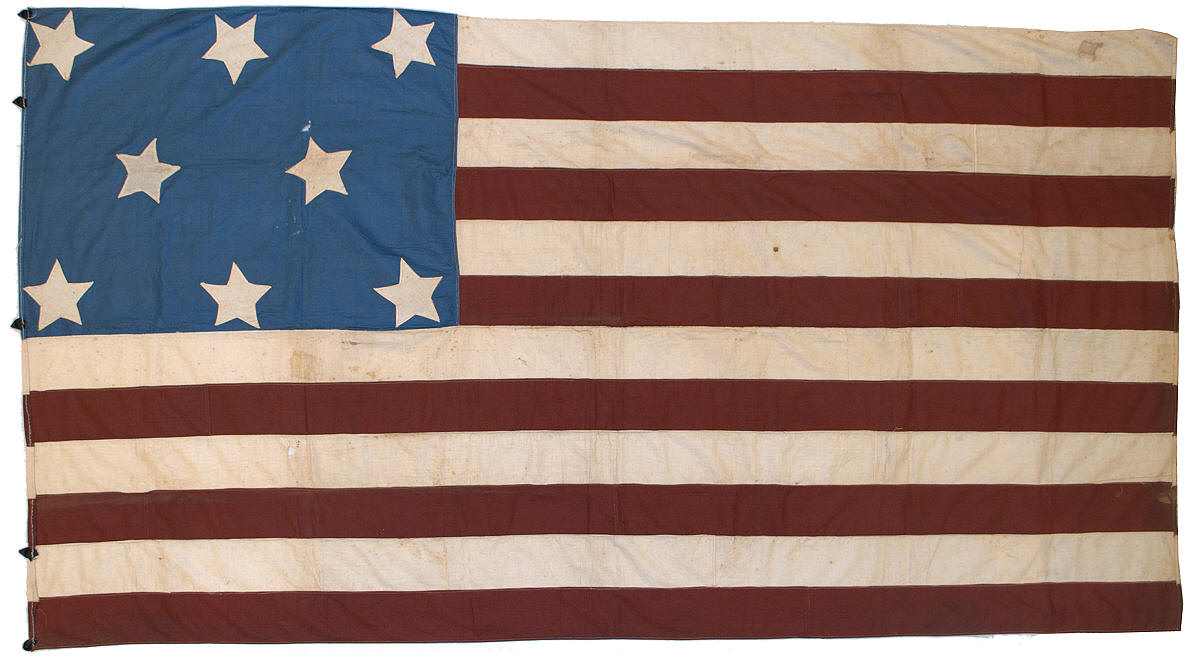 The
reason for the unusual characteristics of this rare
antique American flag are not completely certain, but
the flag is a good example of how, by examining many
attributes of a flag, we can make a reasonable
explanation for
why a flag appears as it does. This flag surfaced
in recent times Florida, but its previous history is
lost. One of the first things that comes to mind
when finding an American flag with fewer than 13 stars
or 13 stripes is that it is somehow associated with the
Confederacy. In the early years of the Civil War,
before the adoption of the First National Flag of the
Confederacy, also known as the "Stars and Bars", a
number of homemade flags were made in the southern
states that resembled the American flag, but with stars
and stripes representing the Confederacy. These
prototype Confederate flags are extremely rare, and
finding an example is of major importance.
According to sources, "a contest organized in 1861 to
select a design for a flag of the Confederacy included,
according to the chairman's report, 'a mass of models or
designs more or less copied from the United States
flag."1
Whether or not this flag was actually submitted to the
contest of 1861, its form and format are evidence that
it is in fact a Confederate prototype flag. The
reason for the unusual characteristics of this rare
antique American flag are not completely certain, but
the flag is a good example of how, by examining many
attributes of a flag, we can make a reasonable
explanation for
why a flag appears as it does. This flag surfaced
in recent times Florida, but its previous history is
lost. One of the first things that comes to mind
when finding an American flag with fewer than 13 stars
or 13 stripes is that it is somehow associated with the
Confederacy. In the early years of the Civil War,
before the adoption of the First National Flag of the
Confederacy, also known as the "Stars and Bars", a
number of homemade flags were made in the southern
states that resembled the American flag, but with stars
and stripes representing the Confederacy. These
prototype Confederate flags are extremely rare, and
finding an example is of major importance.
According to sources, "a contest organized in 1861 to
select a design for a flag of the Confederacy included,
according to the chairman's report, 'a mass of models or
designs more or less copied from the United States
flag."1
Whether or not this flag was actually submitted to the
contest of 1861, its form and format are evidence that
it is in fact a Confederate prototype flag.
The 8 stars of the flag
represent Virginia, the 8th state to secede from the
Union on April 17, 1861. During this time, it was
unclear which states would eventually secede, though
Maryland, a slave state and one of two "Border States"
along with Delaware, was also strong candidate for
secession, so an expectation of 12 states, as
represented by the 12 stripes of this flag, would be
reasonable. Arkansas seceded just 20 days after
Virginia, which means it's likely this flag was made at
either the end of April or beginning of May, 1861.
The canton of the flag is a polished cotton chintz, a
very fine fabric of high quality. The stripes are
also of cotton, though not polished, and the red of the
stripes is a deep burgundy red. A small group of
Civil War era flags are known with very similar
characteristics and coloring, including a 33 star flag
also on a light blue polished cotton canton that also
dates to the opening period of the war. Although
the stars and stripes are treadle sewn in a fine stitch,
many of the stripes are pieced together using vertical
hand-sewn seams. Upon first inspection, I noticed
five black tabs sewn to the hoist of the flag, which are
made of what seems to be nylon, and appear much more
modern than the rest of the flag. Also the hoist
seems to have been folded back and sewn with newer
thread than the rest of the flag, as part of the process
of affixing the nylon tabs. This was probably done
in the mid or late 20th century, perhaps in 1961 during
the 100th anniversary of the Civil War. The tabs clearly
were not intended for long-term use, and are certainly
not original to the flag. Confederate flags are an
important part of any collection of American flags.
They were made by Americans in a time of great civil
strife, and they represent a history and heritage that
is part of the America we know today.
1 Boleslaw
Mastai, The Stars and the Stripes, Alfred A.
Knopf, New York, 1973, p. 137 |

